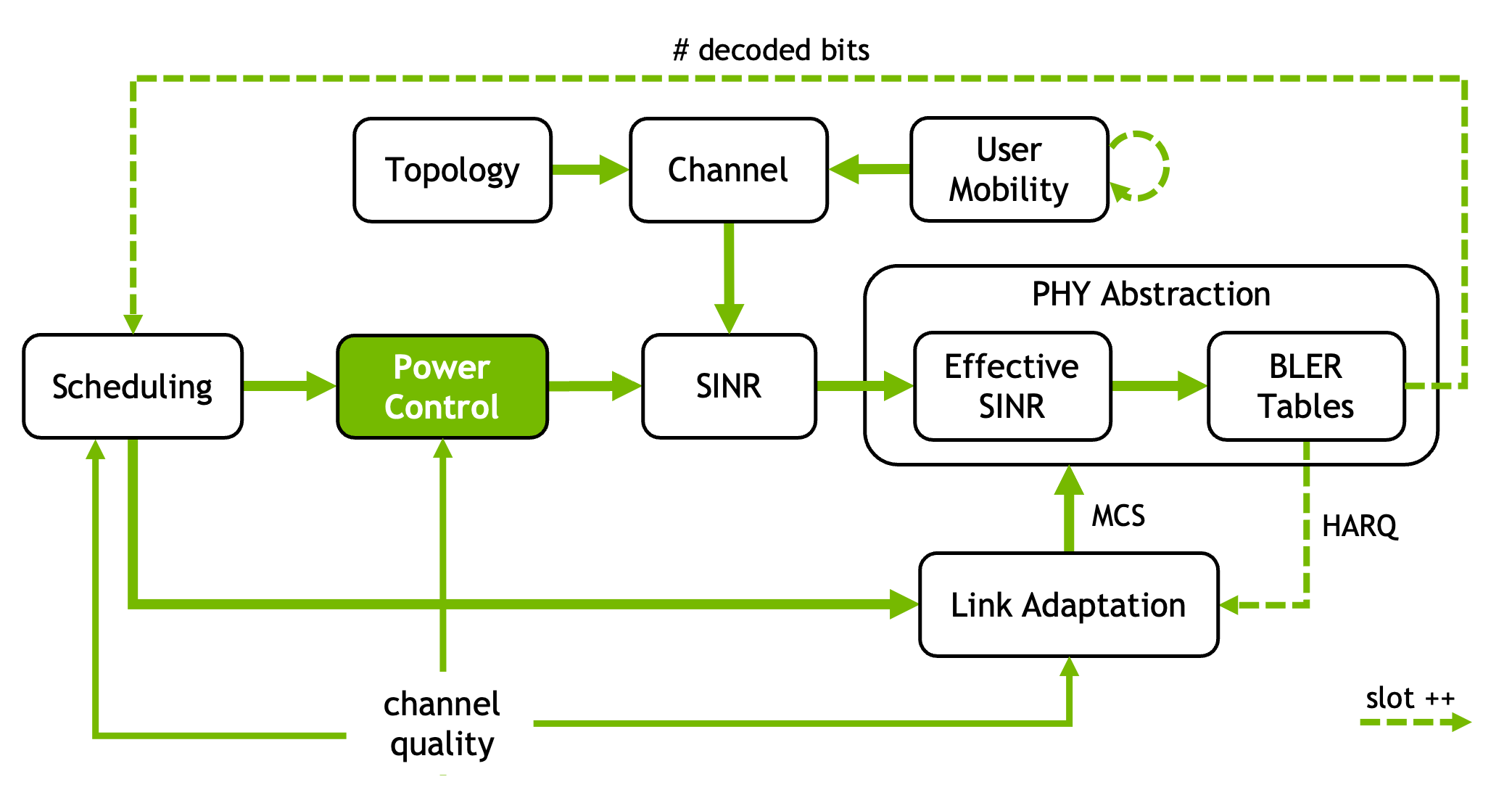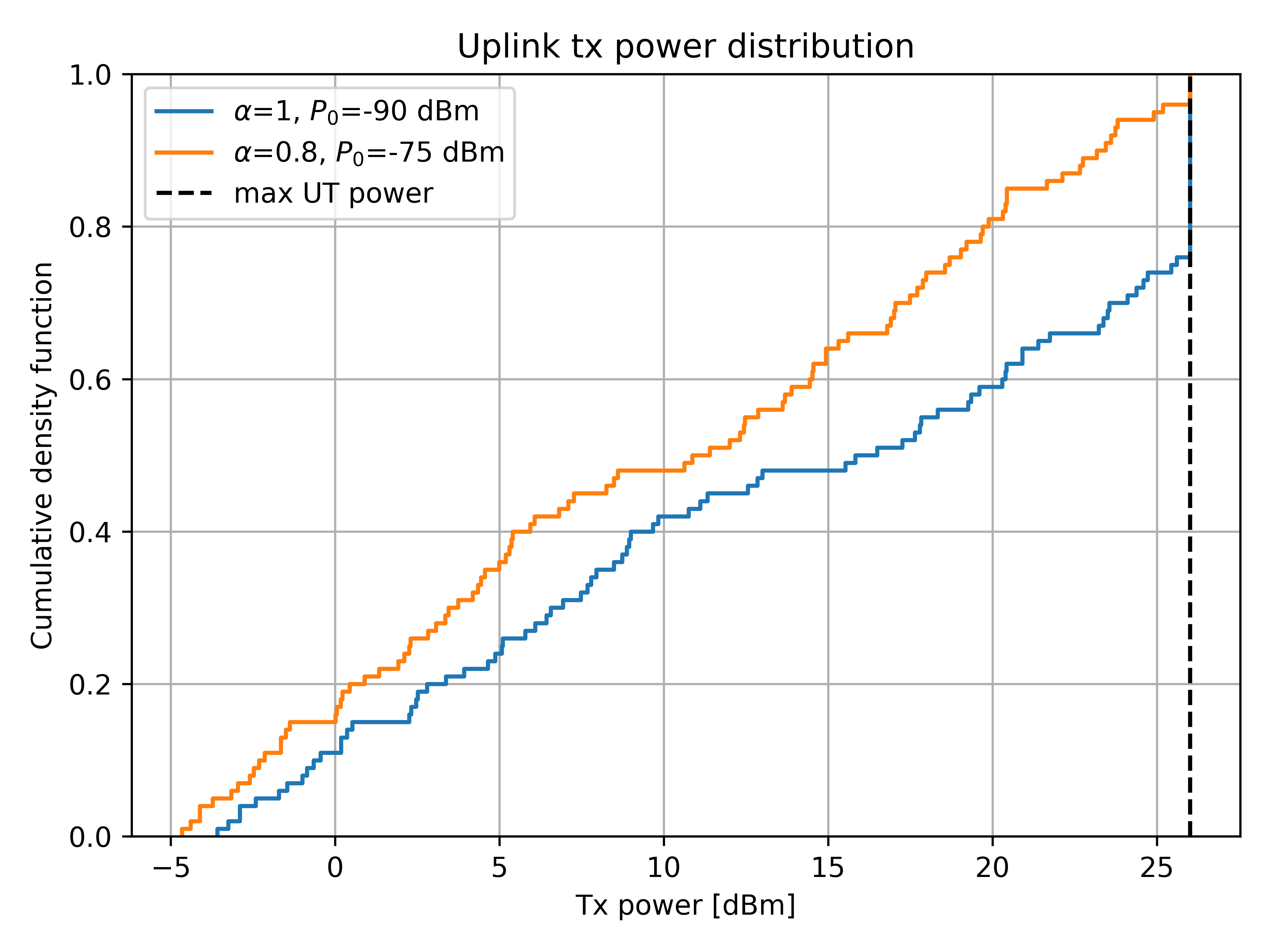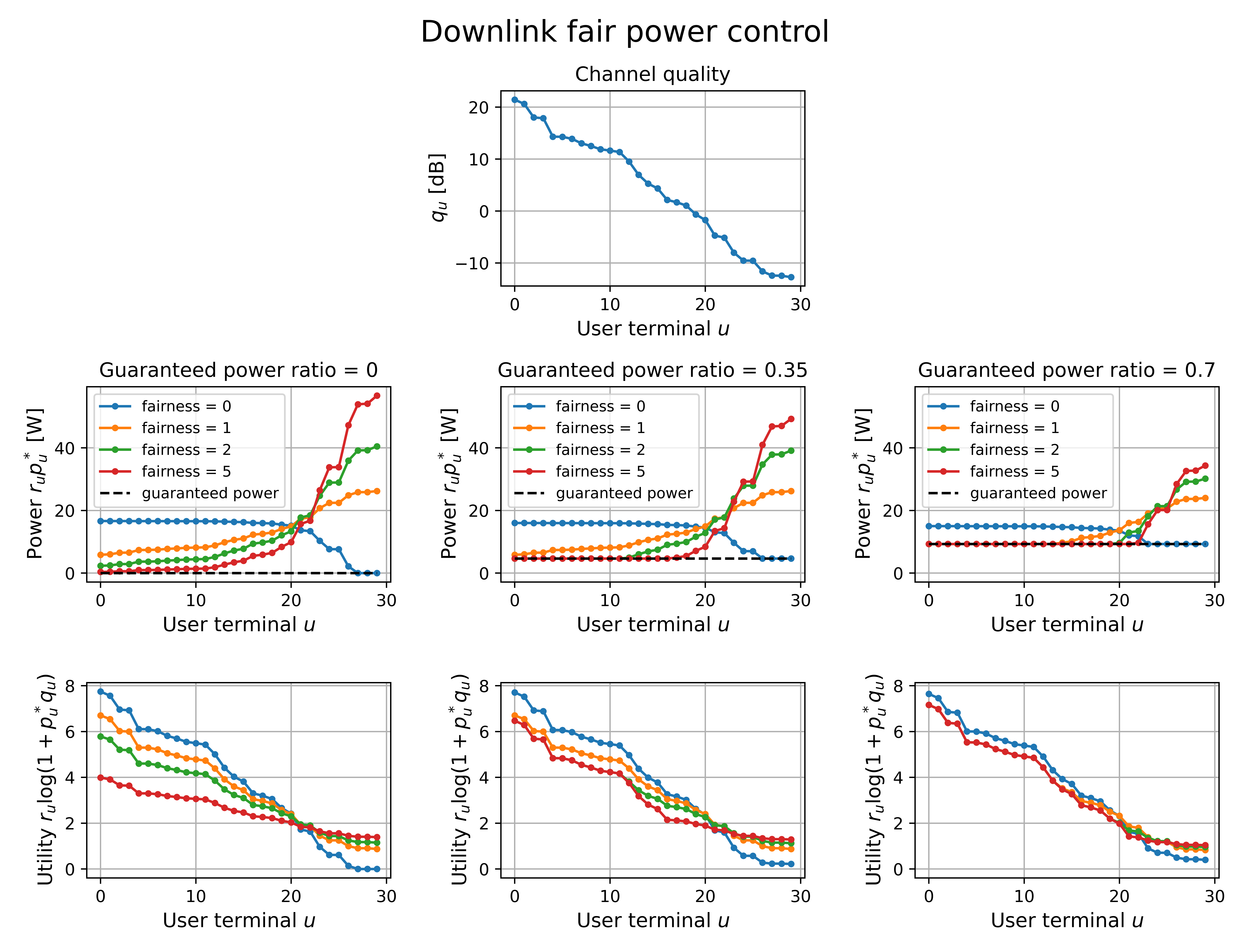Power Control

Upon scheduling users to available resources, the transmission power must be adjusted to ensure that users receive the desired quality of service while minimizing interference to other users.
In the uplink, the user terminal typically aims at (partially) compensating for the pathloss to reach a target received power at the base station. In the downlink, the base station distributes the available power budget across users according to a certain fairness criterion.
For an example of how to adjust transmission power in Sionna, refer to the Power Control notebook.
Uplink
- sionna.sys.open_loop_uplink_power_control(pathloss, num_allocated_subcarriers, alpha=1.0, p0_dbm=-90.0, ut_max_power_dbm=26.0, precision=None)[source]
Implements an open-loop uplink power control procedure inspired by 3GPP TS 38.213, Section 7.1.1 [3GPP38213].
For each user, the uplink transmission power \(P^{\mathrm{UL}}\) is computed as:
\[P^{\mathrm{UL}} = \min \{ P_0 + \alpha PL + 10 \log_{10}(\mathrm{\#PRB}), \ P^{\mathrm{max}}\} \quad [\mathrm{dBm}]\]where \(P^{\mathrm{max}}\) is the maximum power, \(P_0\) [dBm] is the target received power per Physical Resource Block (PRB), \(PL\) is the pathloss and \(\alpha\in [0,1]\) is the pathloss compensation factor.
Note that if \(\alpha=1\), the pathloss is fully compensated and the power per PRB received by the base station equals \(P_0\) [dBm], assuming \(P^{\mathrm{max}}\) is not reached. Lower values of \(\alpha\) can help reducing interference caused to neighboring cells.
With respect to 3GPP TS 38.213, additional factors such as closed-loop control and transport format adjustments are here ignored
- Input:
pathloss ([…, num_ut], tf.float) – Pathloss for each user relative to the serving base station, in linear scale
num_allocated_subcarriers ([…, num_ut]) – Number of allocated subcarriers for each user
alpha ([…, num_ut], tf.float | float (default: 1.0)) – Pathloss compensation factor. If a float, the same value is applied to all users.
p0_dbm ([…, num_ut], tf.float | float (default: -90.0)) – Target received power per PRB. If a float, the same value is applied to all users.
ut_max_power_dbm ([…, num_ut], tf.float | float (default: 26.0)) – Maximum transmit power [dBm] for each user. If a float, the same value is applied to all users.
precision (None (default) | “single” | “double”) – Precision used for internal calculations and outputs. If set to None,
precisionis used.
- Output:
tx_power_per_ut ([…, num_ut], tf.float) – Uplink transmit power [W] for each user, across subcarriers, streams and time steps
Example
import matplotlib.pyplot as plt from sionna.sys import open_loop_uplink_power_control from sionna.phy import config from sionna.phy.utils import db_to_lin, watt_to_dbm # N. users num_ut = 100 # Max tx power per UT ut_max_power_dbm = 26 # [dBm] # Pathloss [dB] pathloss_db = config.tf_rng.uniform([num_ut], minval=80, maxval=120) # N. allocated subcarriers per UT num_allocated_subcarriers = tf.fill([num_ut], 40) # Parameters (pathloss compensation factor, reference rx power) alpha_p0 = [(1, -90), (.8, -75)] for alpha, p0, in alpha_p0: # Power allocation tx_power_per_ut = open_loop_uplink_power_control(db_to_lin(pathloss_db), num_allocated_subcarriers=num_allocated_subcarriers, alpha=alpha, p0_dbm=p0, ut_max_power_dbm=ut_max_power_dbm) # Plot CDF of tx power plt.ecdf(watt_to_dbm(tx_power_per_ut), label=fr'$\alpha$={alpha}, $P_0$={p0} dBm') # Plot max UT power plt.plot([ut_max_power_dbm]*2, [0, 1], 'k--', label='max UT power') plt.legend() plt.grid() plt.xlabel('Tx power [dBm]') plt.ylabel('Cumulative density function') plt.title('Uplink tx power distribution') plt.show()

Downlink
- sionna.sys.downlink_fair_power_control(pathloss, interference_plus_noise, num_allocated_re, bs_max_power_dbm=56.0, guaranteed_power_ratio=0.5, fairness=0.0, return_lagrangian=False, precision=None, **kwargs)[source]
Allocates the downlink transmit power fairly across all users served by a single base station (BS)
The maximum BS transmit power \(\overline{P}\) is distributed across users by solving the following optimization problem:
\[\begin{split}\begin{align} \mathbf{p}^* = \operatorname{argmax}_{\mathbf{p}} & \, \sum_{u=1}^{U} g^{(f)} \big( r_u \log( 1 + p_u q_u) \big) \\ \mathrm{s.t.} & \, \sum_{u=1}^U r_u p_u = \overline{P} \\ & r_u p_u \ge \rho \frac{\overline{P}}{U} , \quad \forall \, u=1,\dots,U \end{align}\end{split}\]where \(q_u\) represents the estimated channel quality, defined as the ratio between the channel gain (being the inverse of pathloss) and the interference plus noise ratio, \(r_u>0\) denotes the number of allocated resources, and \(p_u\) is the per-resource allocated power, for every user \(u\).
The parameter \(\rho\in[0;1]\) denotes the guaranteed power ratio; if set to 1, the power is distributed uniformly across all users.
The fairness function \(g^{(f)}\) is defined as in [MoWalrand]:
\[\begin{split}\begin{align} g^{(f)}(x) = \left\{ \begin{array}{l} \log(x), \quad f=1 \\ \frac{x^{1-f}}{1-f}, \quad \forall\, f>0, \ f\ne 1. \end{array} \right. \end{align}\end{split}\]When the fairness parameter \(f=0\), the sum of utilities \(\log( 1 + p_u q_u)\) is maximized, leading to a waterfilling-like solution (see, e.g., [Tse]). As \(f\) increases, the allocation becomes increasingly egalitarian. The case \(f=1\) maximizes proportional fairness; as \(f\to \infty\), the solution approaches a max-min allocation.
For optimal power allocations \(p^*_u>\frac{\overline{P}}{U r_u}\), the Karush-Kuhn-Tucker (KKT) conditions can be expressed as:
\[\big[ r_u \log (1+p^*_u q_u) \big]^f (1+p^*_u q_u) = q_u \mu^{-1}, \quad \forall \, u\]where \(\mu\) is the Lagrangian multiplier associated with the constraint on the total transmit power.
This function returns the optimal power allocation \(r_u p_u^*\) and the corresponding utility \(r_u \log( 1 + p^*_u q_u)\), for each user \(u=1,\dots,U\). If
return_lagrangianis True, \(\mu^{-1}\) is returned, too.- Input:
pathloss ([…, num_ut], tf.float) – Pathloss for each user in linear scale
interference_plus_noise ([…, num_ut], tf.float | float) – Interference plus noise [Watt] for each user. If float, the same value is assigned to all users.
num_allocated_re ([…, num_ut], tf.int32 | int) – Number of allocated resources to each user. If int, the same value is assigned to all users.
bs_max_power_dbm ([…], tf.float | float (default: 56.)) – Maximum transmit power for the base station [dBm]. If float, the same value is assigned to all batches.
guaranteed_power_ratio (float (default: 0.2)) – The power allocated to a user is guaranteed to exceed a portion
guaranteed_power_ratioofbs_max_power_dbmdivided by the number of scheduled users. Must be within [0;1].fairness (float (default: 0.)) – Fairness parameter. If 0, the sum of utilities is maximized; when 1, proportional fairness is achieved. As
fairnessincreases, the optimal allocation approaches a max-min one.return_lagrangian (bool (default: False)) – If True, the inverse of the optimal Lagrangian multiplier
mu_inv_staris returnedprecision (None (default) | “single” | “double”) – Precision used for internal calculations and outputs. If set to None,
precisionis used.kwargs (dict) – Additional inputs for
bisection_method()used to compute the optimal power allocation, such aseps_x,eps_y,max_n_iter,step_expand
- Output:
tx_power ([…, num_ut], tf.float) – Optimal downlink power allocation \(p_u^*\) [Watt] for each user \(u\)
utility ([…, num_ut], tf.float) – Optimal utility for each user, computed as \(r_u \log( 1 + p^*_u q_u)\) for user \(u\)
mu_inv_star ([…], tf.float) – Inverse of the optimal Lagrangian multiplier \(\mu\) associated with the total power constraint. Only returned if
return_lagrangianis True.
Example
import tensorflow as tf import numpy as np import matplotlib.pyplot as plt from sionna.phy import config from sionna.phy.utils import db_to_lin, dbm_to_watt from sionna.sys import downlink_fair_power_control config.seed = 45 # Evaluate the impact of 'fairness' and 'guaranteed_power_ratio' # parameters on the DL power allocation and utility # Guaranteed power ratios guaranteed_power_ratio_vec = [0, .35, .7] # Fairness parameters fairness_vec = [0, 1, 2, 5] # N. users num_ut = 30 # BS tx power bs_max_power_dbm = 56 max_power_bs = dbm_to_watt(bs_max_power_dbm) # Interference plus noise interference_plus_noise = 5e-10 # [W] # Generate random pathloss pathloss_db = config.tf_rng.uniform( [num_ut], minval=70, maxval=110) # [dB] pathloss = db_to_lin(pathloss_db) # Channel quality cq = 1 / (pathloss * interference_plus_noise) fig, axs = plt.subplots(3, len(guaranteed_power_ratio_vec), figsize=(3.5*len(guaranteed_power_ratio_vec), 8), sharey='row') fig.subplots_adjust(top=0.8) for ax in axs.flatten(): ax.yaxis.set_tick_params(labelbottom=True) ax.grid() ax.set_xlabel(r'User terminal $u$', fontsize=12) # Show channel quality in decreasing order ind_sort = np.argsort(cq)[::-1] axs[0, 1].plot(10*np.log10(cq)[ind_sort], '.-') axs[0, 1].set_ylabel(r'$q_u$ [dB]', fontsize=12) axs[0, 1].set_title('Channel quality') for ii, guar_ratio in enumerate(guaranteed_power_ratio_vec): # Guaranteed power for each user guaranteed_power = guar_ratio * max_power_bs / num_ut for fairness in fairness_vec: # DL fair power allocation tx_power, utility = downlink_fair_power_control( pathloss, interference_plus_noise=interference_plus_noise, num_allocated_re=1, bs_max_power_dbm=bs_max_power_dbm, guaranteed_power_ratio=guar_ratio, fairness=fairness) # Show utility axs[2, ii].plot(utility.numpy()[ind_sort], '.-', label=f'fairness = {fairness}') # Show transmit power axs[1, ii].plot(tx_power.numpy()[ind_sort], '.-', label=f'fairness = {fairness}') axs[1, ii].plot([0, num_ut-1], [guaranteed_power]*2, '--k', label='guaranteed power') axs[1, ii].set_ylabel(r'Power $r_u p^*_u$ [W]', fontsize=12) axs[1, ii].legend(fontsize=9) axs[2, ii].set_ylabel(r'Utility $r_u \log(1+p^*_u q_u)$', fontsize=12) axs[1, ii].set_title(f'Guaranteed power ratio = {guar_ratio}') fig.suptitle('Downlink fair power control', y=.98, fontsize=18) fig.tight_layout() fig.delaxes(axs[0, 0]) fig.delaxes(axs[0, 2]) plt.show()

References: